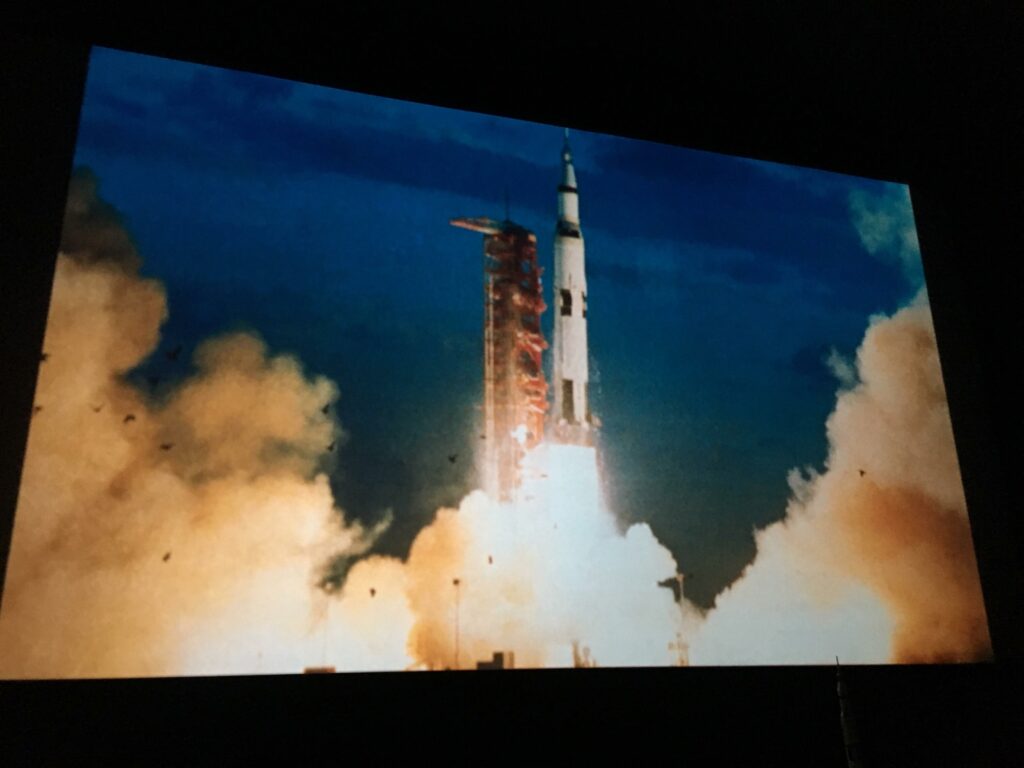VERO BEACH — Director and filmmaker Zachary Weil might not have been born when the Apollo spacecraft’s lunar module landed on the moon in 1969, but that didn’t stop the 37-year-old from preserving the history of what many consider mankind’s most technological achievement to date.
In 2017, Weil began speaking with those behind the scenes who made former President John F. Kennedy’s goal of sending man to the moon – and beating the Russians in the process – a reality. He developed a documentary, ‘When We Were Apollo,’ which had a private screening Wednesday at Majestic Theatre of Vero Beach as a fundraiser for Laura Riding Jackson Foundation, an organization that promotes literacy and offers a variety of educational writing workshops and programs for teens and adults.
The film was finished in the spring, Weil said. The motion-picture was shown on Public Broadcasting Service in July, which marked the 50th anniversary of the moon landing.
“When We Were Apollo” documentary private screening held at Majestic Theatre Vero Beach Wednesday. The documentary tells the stories of technicians, programmers, and others who worked on the Apollo mission to send man to the moon. #VeroNews pic.twitter.com/QN2zds075Y
— Nicholas Samuel (@JournalistNickS) November 14, 2019
In the film, Weil spoke to engineers, mathematicians, programmers and writers, including Vero Beach resident Martha Lemasters, 82. Lemasters worked as a marketing communications writer for the Apollo mission at Cape Canaveral.
Martha Lemasters speaks about the Apollo program in the ‘When We Were Apollo’ documentary. PHOTO BY NICK SAMUEL
“There’s this bond the country shares because of this history. It’s wonderful to be able to participate in it,” said Weil, of Los Angeles, California. “I feel a little jealous. If someone offered me a time machine to see what was going on then, I wouldn’t miss a beat.”
Weil said he wants to share the experience of the Apollo 11 mission with the newer generations that didn’t live through it. His documentary captured interviews with National Aeronautics and Space Administration employees and others who worked under contract with NASA.
“I think it’s important because the public usually doesn’t understand that NASA was mostly overseeing the Apollo program, but most of the work was done by contractors or private companies (except for the astronauts who were NASA employees),” former IBM Systems and Programming and Advanced Programs Senior Manager Jim Handley, of Cocoa Beach, said.
The film showed old footage of newspaper clippings, the massive Saturn V rocket and astronauts landing on the lunar surface.
“We don’t pay enough attention to our past to use it as a compass to get us where we need to be as individuals and as a society,” Weil said.
The massive Saturn V, a liquid-propellant expendable rocket, was used during the Apollo program to help bring man to the moon. The 363-foot tall rocket used for the Apollo 11 mission carried astronauts Neil Armstrong, Buzz Aldrin and Michael Collins as it blasted off from Kennedy Space Center July 16, 1969.
Vintage footage of former President John F. Kennedy seen in the documentary ‘When We Were Apollo.’
PHOTO BY NICK SAMUEL
“We shall send man to the moon,” Kennedy said during a speech in an old vintage clip. “Do it right, do it first. It will be done by the end of the decade.”
About 100 space enthusiasts were in attendance at the private screening, including two engineers who did contract work for NASA. Attendees were able to ask questions to those who worked on the Apollo program in a Q & A session, including Lemasters, Handley and former IBM Programmer Ken Clark, of Merritt Island.
Audience members heard countdowns before seeing enormous balls of fire erupt and blast a rocket into the sky on the big screen.
The documentary talked about the great space race between the United States and Russia following World War II. The two nations competed to achieve firsts in spaceflight capability, including launching artificial satellites; unmanned space probes of the moon, Venus and Mars; and manned space flights in low earth orbit and eventually to the moon.
NASA – established in 1958 – was created to lead U.S. space exploration efforts. There were about 440,000 employees, from writers to mission control specialists and engineers, who worked on various tasks during the Apollo program.
“(Viewers) need to know what the average people did during the program, not just the astronauts,” Lemasters said.
The film also showed how Kennedy urged for equal employment opportunities and pushed NASA and its contractors to hire more African-Americans. The motion-picture portrayed the emotional toll working for the Apollo mission had on employees who worked long hours.
Former President John F. Kennedy pushed NASA and its contractors to hire more African-Americans.
PHOTO BY NICK SAMUEL
Longer work hours led to less time spent with children and spouses. After that came marriage troubles and eventually divorce, which was the fate of several employees.
But, their hard work and dedication was not in vain. Space enthusiasts said it imprinted a legacy in American history and culture.
“It’s a legacy worth preserving,” Weil said. “When we hit the 100th anniversary, there will be an incredible archive.”
Weil is currently working on producing a movie behind Lemasters’ 2016 memoir ‘The Step,’ which details her journey working at the Kennedy Space Center during the Apollo program.
Photos by Nick Samuel

